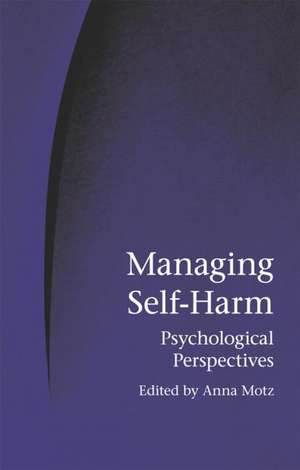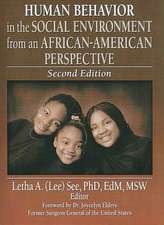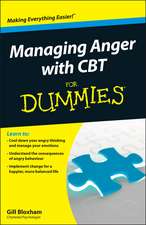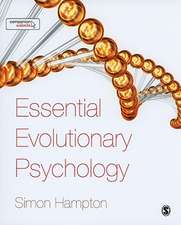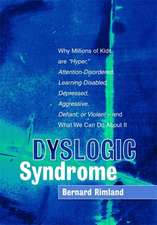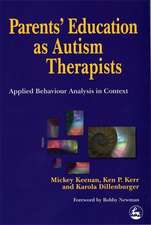Managing Self-Harm: Psychological Perspectives
Editat de Anna Motzen Limba Engleză Paperback – 3 iul 2009
Each chapter integrates theory with clinical illustration, enabling the direct experiences of those who self-harm to be heard and reflecting the populations that are most likely to self-harm. The contributors are drawn from a wide range of backgrounds, including clinical psychology, psychotherapy, group analysis and psychiatric nursing.
Areas of discussion include:
- self-harm and young people in foster care and residential settings
- self-harm in women’s secure services
- self-harm in people diagnosed with personality disorder
Preț: 342.84 lei
Nou
Puncte Express: 514
Preț estimativ în valută:
65.60€ • 68.68$ • 54.28£
65.60€ • 68.68$ • 54.28£
Carte tipărită la comandă
Livrare economică 07-21 aprilie
Preluare comenzi: 021 569.72.76
Specificații
ISBN-13: 9781583917053
ISBN-10: 1583917055
Pagini: 248
Ilustrații: 1 Tables, black and white; 1 Illustrations, black and white
Dimensiuni: 138 x 216 x 15 mm
Greutate: 0.3 kg
Ediția:UK edition
Editura: Taylor & Francis
Colecția Routledge
Locul publicării:Oxford, United Kingdom
ISBN-10: 1583917055
Pagini: 248
Ilustrații: 1 Tables, black and white; 1 Illustrations, black and white
Dimensiuni: 138 x 216 x 15 mm
Greutate: 0.3 kg
Ediția:UK edition
Editura: Taylor & Francis
Colecția Routledge
Locul publicării:Oxford, United Kingdom
Public țintă
Postgraduate, Professional, and Professional Practice & DevelopmentCuprins
Motz, Introduction. Part I: Understanding Self-Harm. Motz, Self-Harm as a Sign of Hope. Motz, Jones, The Paradox of Self-Harm. Part II: The Wider Context: Systemic Issues and Self-Harm. Scanlon, Adlam, "Why Do You Treat Me This Way?" Reciprocal Violence and the Mythology of Self-Harm. Norris, Maher, The Trap: Self-Harm and Young People in Foster Care and Residential Settings. Grocutt, Self-Harm and Attachment. Part III: Women, Self-Harm and Treatment Issues. Kleinot, Speaking with the Body. Greenwood, Absences, Transitions and Endings: Threats to Successful Treatment. Lawday, Self-Harm in Women’s Secure Services: Reflections and Strategies for Treatment Design. Grocutt, Self-Harm Cessation in Secure Units. Motz, Conclusion: "If You Prick Us Do We Not Bleed?" The Meaning and Management of Self-Harm.
Recenzii
"Caring for people who harm themselves is hard work. This excellent collection of papers, ably edited by Anna Motz, will help those of us who do this difficult work to do it better." - Dr Gwen Adshead, Consultant Forensic Psychotherapist, Broadmoor Hospital, UK
"This book is a welcome antidote to the powerful tendency to see self-harm only as a behaviour that must be stopped, usually because of the feelings the action evokes in others. The authors' exploration of the meaning and communication behind the act offers those that treat or care for people who self-harm a greater understanding on which to base their responses and build a therapeutic approach. The work is based on the words of those that self-harm, as well as theory, the clinical material of experienced clinicians, and research and should go a long way to improving the services offered to those that self-harm." - Dr Diana Menzies, Consultant Psychiatrist in Psychotherapy, Henderson Hospital Therapeutic Community, UK
"This is a book which challenges on a number of levels and is refreshing and interesting to read. With contributions from clinicians and practitioners, as well as those who self-harm, the reader is invited to see self-harming behaviour as a form of language, and to think carefully about its meaning. It is both compassionate and unflinching, offering suggestions about understanding behaviours which are difficult to experience, to witness and to read about... It does not shy away from difficult issues or complex theoretical discussion, yet it would be accessible to practitioners and managers in a variety of settings. I would also whole-heartedly recommend this book for students. It implicitly questions the often crass distinctions between the ‘medical’ and ‘social’ models offered up (particularly) to social work students. This collection also provides a sustained and illuminating application of psychodynamic and systemic theories, in context, unvarnished, and always thought-provoking." - Alison Higgs, Journal of Social Work Practice, Vol. 24 No. 2, June 2010
"...this is an excellent book... It would most certainly provide an excellent text for the continuing professional development of mental health and social work practitioners, whether as part of a course or in one’s own reading. It would also, I think, be of great value for those in initial training for such roles... It is above all, a book which challenges simplistic notions that self-harm is easily defined, inexplicable, wicked, irrational or without benefit to the person concerned, and that the sole objective of carers must be to stop it as quickly as possible." - Ron Best, British Journal of Guidance & Counselling, Vol 39, No 4, August 2011
"Caring for people who harm themselves is hard work. This excellent collection of papers, ably edited by Anna Motz, will help those of us who do this difficult work to do it better." - Dr Gwen Adshead, Consultant Forensic Psychotherapist, Broadmoor Hospital, UK
"This book is a welcome antidote to the powerful tendency to see self-harm only as a behaviour that must be stopped, usually because of the feelings the action evokes in others. The authors' exploration of the meaning and communication behind the act offers those that treat or care for people who self-harm a greater understanding on which to base their responses and build a therapeutic approach. The work is based on the words of those that self-harm, as well as theory, the clinical material of experienced clinicians, and research and should go a long way to improving the services offered to those that self-harm." - Dr Diana Menzies, Consultant Psychiatrist in Psychotherapy, Henderson Hospital Therapeutic Community, UK
"This is a book which challenges on a number of levels and is refreshing and interesting to read. With contributions from clinicians and practitioners, as well as those who self-harm, the reader is invited to see self-harming behaviour as a form of language, and to think carefully about its meaning. It is both compassionate and unflinching, offering suggestions about understanding behaviours which are difficult to experience, to witness and to read about... It does not shy away from difficult issues or complex theoretical discussion, yet it would be accessible to practitioners and managers in a variety of settings. I would also whole-heartedly recommend this book for students. It implicitly questions the often crass distinctions between the ‘medical’ and ‘social’ models offered up (particularly) to social work students. This collection also provides a sustained and illuminating application of psychodynamic and systemic theories, in context, unvarnished, and always thought-provoking." - Alison Higgs, Journal of Social Work Practice, Vol. 24 No. 2, June 2010
"The book can help social workers understand the theoretical underpinnings of this complicated behavioral attack on the body, while also offering clinical cases to illuminate how multi-disciplinary professionals can and do respond in these situations." - Michelle R. Munson, Clinical Social Work Journal
"This book is a welcome antidote to the powerful tendency to see self-harm only as a behaviour that must be stopped, usually because of the feelings the action evokes in others. The authors' exploration of the meaning and communication behind the act offers those that treat or care for people who self-harm a greater understanding on which to base their responses and build a therapeutic approach. The work is based on the words of those that self-harm, as well as theory, the clinical material of experienced clinicians, and research and should go a long way to improving the services offered to those that self-harm." - Dr Diana Menzies, Consultant Psychiatrist in Psychotherapy, Henderson Hospital Therapeutic Community, UK
"This is a book which challenges on a number of levels and is refreshing and interesting to read. With contributions from clinicians and practitioners, as well as those who self-harm, the reader is invited to see self-harming behaviour as a form of language, and to think carefully about its meaning. It is both compassionate and unflinching, offering suggestions about understanding behaviours which are difficult to experience, to witness and to read about... It does not shy away from difficult issues or complex theoretical discussion, yet it would be accessible to practitioners and managers in a variety of settings. I would also whole-heartedly recommend this book for students. It implicitly questions the often crass distinctions between the ‘medical’ and ‘social’ models offered up (particularly) to social work students. This collection also provides a sustained and illuminating application of psychodynamic and systemic theories, in context, unvarnished, and always thought-provoking." - Alison Higgs, Journal of Social Work Practice, Vol. 24 No. 2, June 2010
"...this is an excellent book... It would most certainly provide an excellent text for the continuing professional development of mental health and social work practitioners, whether as part of a course or in one’s own reading. It would also, I think, be of great value for those in initial training for such roles... It is above all, a book which challenges simplistic notions that self-harm is easily defined, inexplicable, wicked, irrational or without benefit to the person concerned, and that the sole objective of carers must be to stop it as quickly as possible." - Ron Best, British Journal of Guidance & Counselling, Vol 39, No 4, August 2011
"Caring for people who harm themselves is hard work. This excellent collection of papers, ably edited by Anna Motz, will help those of us who do this difficult work to do it better." - Dr Gwen Adshead, Consultant Forensic Psychotherapist, Broadmoor Hospital, UK
"This book is a welcome antidote to the powerful tendency to see self-harm only as a behaviour that must be stopped, usually because of the feelings the action evokes in others. The authors' exploration of the meaning and communication behind the act offers those that treat or care for people who self-harm a greater understanding on which to base their responses and build a therapeutic approach. The work is based on the words of those that self-harm, as well as theory, the clinical material of experienced clinicians, and research and should go a long way to improving the services offered to those that self-harm." - Dr Diana Menzies, Consultant Psychiatrist in Psychotherapy, Henderson Hospital Therapeutic Community, UK
"This is a book which challenges on a number of levels and is refreshing and interesting to read. With contributions from clinicians and practitioners, as well as those who self-harm, the reader is invited to see self-harming behaviour as a form of language, and to think carefully about its meaning. It is both compassionate and unflinching, offering suggestions about understanding behaviours which are difficult to experience, to witness and to read about... It does not shy away from difficult issues or complex theoretical discussion, yet it would be accessible to practitioners and managers in a variety of settings. I would also whole-heartedly recommend this book for students. It implicitly questions the often crass distinctions between the ‘medical’ and ‘social’ models offered up (particularly) to social work students. This collection also provides a sustained and illuminating application of psychodynamic and systemic theories, in context, unvarnished, and always thought-provoking." - Alison Higgs, Journal of Social Work Practice, Vol. 24 No. 2, June 2010
"The book can help social workers understand the theoretical underpinnings of this complicated behavioral attack on the body, while also offering clinical cases to illuminate how multi-disciplinary professionals can and do respond in these situations." - Michelle R. Munson, Clinical Social Work Journal
Descriere
Designed to help clinicians, people who self-harm and their families and carers to understand its causes, meaning and treatment, this book explores unconscious meanings for self-harming and the sense in which it is a language of the body.
